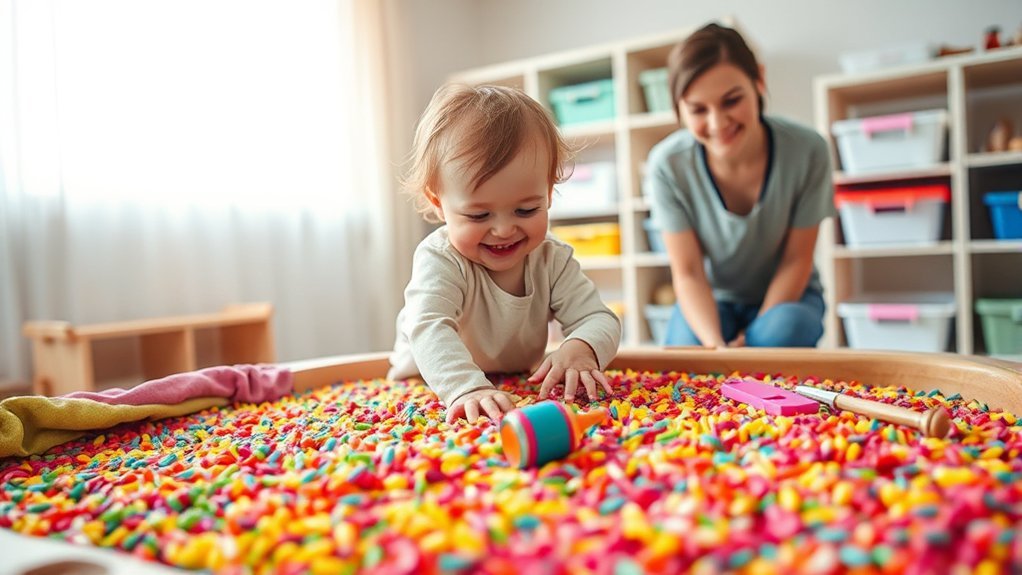Have you ever wondered how sensory play can transform your child’s learning experience? Engaging in sensory activities isn’t just fun; it offers numerous developmental benefits. However, to maximize those benefits, it’s essential to know the do’s and don’ts of sensory play. By following some simple guidelines, you can create a safe and enriching environment that sparks curiosity. Let’s explore how to make the most of these engaging activities while avoiding common pitfalls.
Benefits of Sensory Play
When you engage in sensory play with children, you’re not just having fun; you’re also providing them with invaluable developmental benefits.
Sensory play enhances cognitive skills by stimulating curiosity and encouraging exploration. It supports fine motor development as children manipulate different materials, strengthening their hand-eye coordination.
Engaging the senses also promotes emotional growth, helping kids express feelings and reduce anxiety. Additionally, sensory play fosters social skills as children collaborate and share experiences, learning to communicate effectively with peers.
Sensory play nurtures emotional growth and social skills, helping children express feelings and communicate effectively with peers.
You’ll notice how it boosts creativity, allowing kids to experiment without boundaries. Overall, sensory play creates a rich learning environment that nurtures development in multiple areas, laying a strong foundation for their future growth.
Embrace this playful learning opportunity!
Creative Sensory Play Ideas
How can you turn everyday materials into exciting sensory experiences for children? Start by creating a sensory bin filled with rice or beans, adding scoops and small toys for digging.
You can also mix cornstarch and water to make a fun, gooey substance known as oobleck.
Another idea is to fill a shallow tray with water and let kids explore floating and sinking objects.
If you have some old magazines, let them tear pages and glue them onto cardboard, creating textured collages.
For a fragrant twist, add herbs or spices to playdough.
Finally, set up a nature scavenger hunt, encouraging kids to collect leaves, stones, and flowers to explore different textures and scents.
These simple ideas ignite creativity and curiosity!
Essential Safety Tips
Safety should always be your top priority when engaging in sensory play with children. First, supervise all activities closely to prevent accidents.
Make certain that any materials you use are non-toxic and age-appropriate. For younger children, avoid small items that could pose choking hazards. Always check for allergies, especially when using food items like flour or salt.
Keep a first aid kit handy for minor injuries, and teach children the importance of washing their hands before and after play. Set clear boundaries about what’s acceptable behavior during activities to minimize risks.
Finally, be mindful of the environment—remove any sharp objects or hazards from the area. With these precautions, you can create a safe and enjoyable sensory play experience!
Common Mistakes to Avoid
Even with safety precautions in place, it’s easy to make a few missteps during sensory play. Here are some common mistakes to avoid to guarantee a successful experience:
| Mistake | Consequence | Solution |
|---|---|---|
| Not supervising closely | Safety risks increase | Stay engaged and attentive |
| Overloading sensory input | Kids may feel overwhelmed | Introduce one sensory element at a time |
| Using inappropriate materials | Allergies or messes may occur | Choose safe, non-toxic items |
Encouraging Exploration and Learning
As children immerse themselves in sensory play, they naturally explore their environment, discovering textures, scents, and sounds that spark their curiosity.
To encourage this exploration, create a safe and inviting space filled with diverse materials like sand, water, or clay. Allow them to manipulate these elements freely, fostering creativity and problem-solving skills.
Engage with them by asking open-ended questions about their discoveries, which promotes critical thinking. You can also introduce themed activities that tie into their interests, making learning more relatable and exciting.
Frequently Asked Questions
What Age Is Best for Introducing Sensory Play?
You can introduce sensory play as early as six months old. At this age, babies explore textures and smells, fostering curiosity. Just guarantee the materials are safe and age-appropriate to encourage their developmental growth effectively.
How Long Should Sensory Play Sessions Last?
Most experts recommend sensory play sessions lasting 20 to 30 minutes. This duration keeps your child engaged without overwhelming them. You’ll notice they’re more focused, making the experience enjoyable and beneficial for their development.
Can Sensory Play Be Done Indoors and Outdoors?
Absolutely, you can do sensory play both indoors and outdoors! Each environment offers unique experiences. Indoors, you can control the mess, while outdoors allows for exploration and natural elements. Just get creative and enjoy!
What Materials Should I Avoid for Sensory Play?
Avoid materials like small beads, sharp objects, or toxic substances that could turn your sensory play into a minefield. Stick to safe, natural items instead, letting creativity bloom without worry. Safety’s your best playmate!
How Can I Involve Older Children in Sensory Play?
To involve older children in sensory play, encourage them to create their own activities using materials they enjoy. Let them lead, explore textures, and experiment with different elements, fostering creativity and engagement in the process.
Conclusion
Incorporating sensory play into your child’s routine can open up their creativity and enhance learning in ways you might not expect. By following the do’s and don’ts, you not only guarantee a safe environment but also foster a space where curiosity thrives. Remember, every moment spent exploring textures and sensations is a step toward building essential skills. Embrace the mess and watch as your child’s imagination soars—because in these playful experiences, they’re discovering the world and themselves.
